 Facebook
Facebook
 X
X
 Instagram
Instagram
 TikTok
TikTok
 Youtube
Youtube
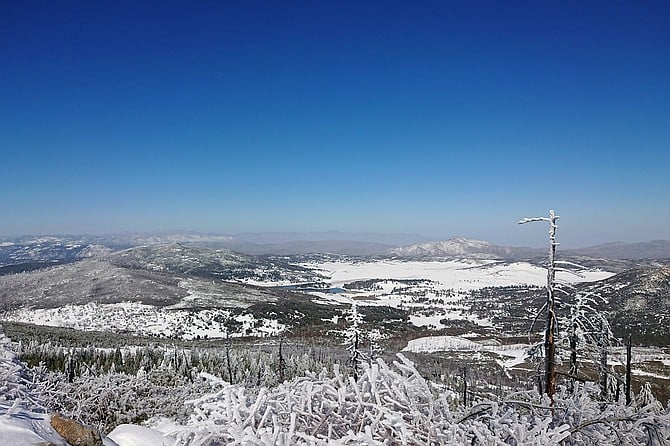
It was a white morning and the first rays of light were gleaming on a snowcapped Cuyamaca Peak. All was calm and quiet, without the slightest breath of wind. Even the birds, which were normally chatty at the first sign of dawn, had slept in. Only now were they beginning to stretch their feathers and flit from bush to fence post. Nearby, a lone deer tiptoed silently through an empty meadow, its ears fluttering from the soft touch of falling snowflakes.
With dawn came new hope about the day’s adventure, as if the sun were stoking the embers of my soul. Though I wanted to absorb the beauty of the moment, I knew I had to start moving before the roads became lined with cars containing young families wanting to give their kids warm memories of the cold snow.
To avoid the bumper-to-bumper traffic to the mountains, I had left home before sunrise, following a dark and lonely road along I-8 up to Paso Picacho Campground, which was closed until the ice-slick roads thawed. Without a place to park, I continued a mile or so north on SR-79 where I found a questionable ditch in which to pull over. The air was cold, but I was bundled from head to toe. My feet were wrapped in thick wool socks and hiking boots, and I wore a long sleeve thermal, a puffy jacket, thick pants, and a beanie.
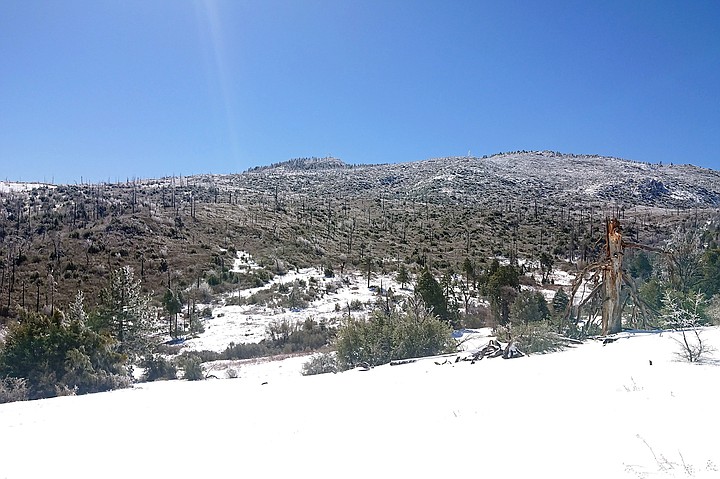
My trekking poles extended, I began up Milk Ranch Road. To my surprise, the path was not fresh, but lined with ski-prints from a fellow wanderer. I trudged alongside their tracks through a foot of snow, which was cold and firm after the long night — unlike my body, which was growing as hot as a furnace from my uphill climb. As I began to sweat, I peeled off my jacket and stored it in my backpack. On bitingly cold days, it’s important to keep your warmest clothes as dry as possible. Otherwise, you’ll reach the peak to find other hikers bundled up and sipping hot cocoa from a thermos while you shiver uncontrollably under the weight of your wet clothes. You’ll wind up sprinting down the trail in a desperate attempt to warm up, all the while wondering when you last felt your hands — not that I’m speaking from experience.
After gaining 500 feet over a mile and a half, the trail diverged three ways, and I took the road less traveled. My plan was to go south towards the peak along the Azalea Spring Fire Road, so I stopped to rest and sipped a bit of water. I felt strong with the fresh mountain air in my lungs, and before my body cooled off, I continued along my path, nodding farewell to the ski-prints and the phantom skier who had left them behind.
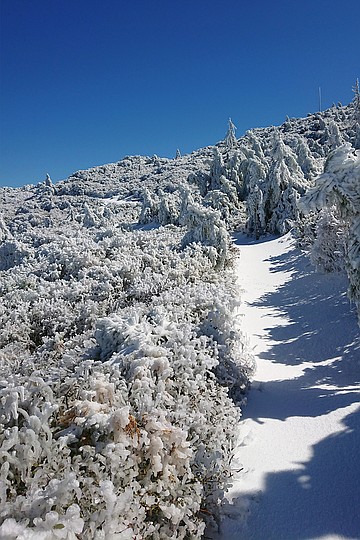
Aside from the distant sound of birds chirping, the landscape was stark and empty, as if the snow had hushed it all. A few minutes after turning on to the fire road, I turned again, up the Conejos Trail. Here the path was completely unbroken and the snow knee-high. Slowly, I took one sinking step then another up the mountain. The higher I climbed, the deeper the snow. The trees were so swollen with ice that their limbs hung heavy over the trail, forcing me to stoop below one branch and then another in order to get through. The further I went, the lower the branches hung, until the final few switchbacks had me crawling on my belly through a tunnel of frozen trees, my head pressed against the snow so that it wouldn’t smack against one of the hundreds of icicles hanging perilously above. During the whole ordeal, my toes grew numb as they sloshed around in my wet socks. But the embers of my heart still glowed with excitement.
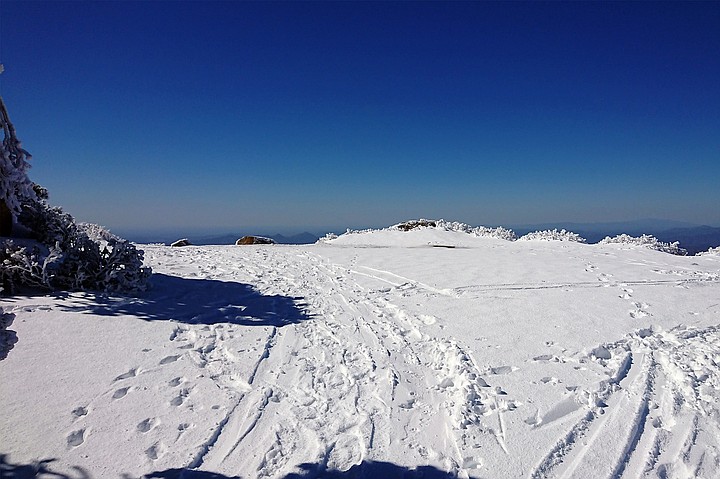
With the switchbacks behind me, I began wayfinding along a flat section of the mountain’s shoulder. The snow had erased nearly every telltale sign of a trail, and my only guide was to follow the gaps between fallen trees that some forester had cut with a chainsaw to clear the trail. It was like following checkpoints in a race, and my finish line was Lookout Road. For most of the year, Lookout Road is just that, a paved road that takes hikers up to Cuyamaca Peak. But today, the black asphalt was buried in snow. Not the pure, white snow that I’d been trudging through, but dirty, sticky snow that was littered with pine needles, dirt, and various boot and paw prints. The kind of snow that’s effortless to walk on.
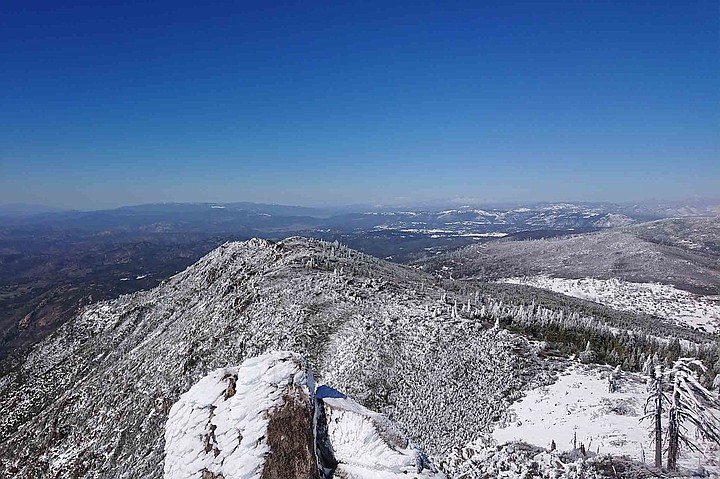
In due time, I made my last few twists and turns up the trail to the peak where I was able to look down on San Diego. The first time I’d seen this view, I was breathless. Now, after several annual trips up the mountain, I caught myself fighting a longstanding urge to laugh. All around me there was snow, snow, snow. On the ground, clinging to the trees, melting in my boots. Winter had filled every nook and cranny. And as I looked down from that snowy plateau into the valleys below, it was amusing to see what little power winter held over the region. The snow quickly gave way to woody chaparral and San Diego looked as it always did: dark green with splotches of brown covering the rolling hills. Instead of seeing the world fall away into a climactic battle between rock and snow, light and shadow stretching to the horizon as it does in the Rockies or the Sierra Nevada, I had the impression that I was standing inside a snow globe.
Not wanting to return to my car by the same path, I journeyed down Lookout Road to Paso Picacho Campground. As I strolled below the canopy of pine trees and neared the now-open parking lot, the din of families grew louder. Drawing nearer, I saw a wide-eyed four-year-old looking at the snow with pure amazement before her eyes returned to her tablet to watch cartoons. Disheartened, I walked north along SR-79 back to my car. After the third truck came barreling down the icy road toward me, I decided that the slippery snowbank I was walking on didn’t offer much protection, so I cut through the snowy meadow where I had spotted the deer at sunrise. Now that the snow had softened below the noon sun, the way was slow and cumbersome. Every footstep seemed to sink deeper, and deeper, and deeper until I stumbled through the icy meadow like a half-dead corpse.
As I returned to my car, I saw that two of the cars parked in the same snowbank as me were trapped. One driver pushed his car while his wife sat snuggly behind the wheel and their kids lobbed snowballs at each other, while the other driver had clearly given up and was napping until help arrived. I worried that my beat-up old car, which I’ve lovingly named Peezuf Shite for all the misfortune it’s brought me, was similarly stuck. I started the car and let it idle for a minute. Then I turned on the 4x4, calmly shifted into first gear, and hit the gas. The back wheels spun and my dinky little car went brrrrrr as it shot to life and lunged onto the road like an Olympic pole vaulter. I could almost hear it growl with menace. With a smirk I went on my way, stopping only at Lake Cuyamaca Restaurant for a much-needed beer and a burger to warm me up.


It was a white morning and the first rays of light were gleaming on a snowcapped Cuyamaca Peak. All was calm and quiet, without the slightest breath of wind. Even the birds, which were normally chatty at the first sign of dawn, had slept in. Only now were they beginning to stretch their feathers and flit from bush to fence post. Nearby, a lone deer tiptoed silently through an empty meadow, its ears fluttering from the soft touch of falling snowflakes.
With dawn came new hope about the day’s adventure, as if the sun were stoking the embers of my soul. Though I wanted to absorb the beauty of the moment, I knew I had to start moving before the roads became lined with cars containing young families wanting to give their kids warm memories of the cold snow.
To avoid the bumper-to-bumper traffic to the mountains, I had left home before sunrise, following a dark and lonely road along I-8 up to Paso Picacho Campground, which was closed until the ice-slick roads thawed. Without a place to park, I continued a mile or so north on SR-79 where I found a questionable ditch in which to pull over. The air was cold, but I was bundled from head to toe. My feet were wrapped in thick wool socks and hiking boots, and I wore a long sleeve thermal, a puffy jacket, thick pants, and a beanie.

My trekking poles extended, I began up Milk Ranch Road. To my surprise, the path was not fresh, but lined with ski-prints from a fellow wanderer. I trudged alongside their tracks through a foot of snow, which was cold and firm after the long night — unlike my body, which was growing as hot as a furnace from my uphill climb. As I began to sweat, I peeled off my jacket and stored it in my backpack. On bitingly cold days, it’s important to keep your warmest clothes as dry as possible. Otherwise, you’ll reach the peak to find other hikers bundled up and sipping hot cocoa from a thermos while you shiver uncontrollably under the weight of your wet clothes. You’ll wind up sprinting down the trail in a desperate attempt to warm up, all the while wondering when you last felt your hands — not that I’m speaking from experience.
After gaining 500 feet over a mile and a half, the trail diverged three ways, and I took the road less traveled. My plan was to go south towards the peak along the Azalea Spring Fire Road, so I stopped to rest and sipped a bit of water. I felt strong with the fresh mountain air in my lungs, and before my body cooled off, I continued along my path, nodding farewell to the ski-prints and the phantom skier who had left them behind.

Aside from the distant sound of birds chirping, the landscape was stark and empty, as if the snow had hushed it all. A few minutes after turning on to the fire road, I turned again, up the Conejos Trail. Here the path was completely unbroken and the snow knee-high. Slowly, I took one sinking step then another up the mountain. The higher I climbed, the deeper the snow. The trees were so swollen with ice that their limbs hung heavy over the trail, forcing me to stoop below one branch and then another in order to get through. The further I went, the lower the branches hung, until the final few switchbacks had me crawling on my belly through a tunnel of frozen trees, my head pressed against the snow so that it wouldn’t smack against one of the hundreds of icicles hanging perilously above. During the whole ordeal, my toes grew numb as they sloshed around in my wet socks. But the embers of my heart still glowed with excitement.

With the switchbacks behind me, I began wayfinding along a flat section of the mountain’s shoulder. The snow had erased nearly every telltale sign of a trail, and my only guide was to follow the gaps between fallen trees that some forester had cut with a chainsaw to clear the trail. It was like following checkpoints in a race, and my finish line was Lookout Road. For most of the year, Lookout Road is just that, a paved road that takes hikers up to Cuyamaca Peak. But today, the black asphalt was buried in snow. Not the pure, white snow that I’d been trudging through, but dirty, sticky snow that was littered with pine needles, dirt, and various boot and paw prints. The kind of snow that’s effortless to walk on.

In due time, I made my last few twists and turns up the trail to the peak where I was able to look down on San Diego. The first time I’d seen this view, I was breathless. Now, after several annual trips up the mountain, I caught myself fighting a longstanding urge to laugh. All around me there was snow, snow, snow. On the ground, clinging to the trees, melting in my boots. Winter had filled every nook and cranny. And as I looked down from that snowy plateau into the valleys below, it was amusing to see what little power winter held over the region. The snow quickly gave way to woody chaparral and San Diego looked as it always did: dark green with splotches of brown covering the rolling hills. Instead of seeing the world fall away into a climactic battle between rock and snow, light and shadow stretching to the horizon as it does in the Rockies or the Sierra Nevada, I had the impression that I was standing inside a snow globe.
Not wanting to return to my car by the same path, I journeyed down Lookout Road to Paso Picacho Campground. As I strolled below the canopy of pine trees and neared the now-open parking lot, the din of families grew louder. Drawing nearer, I saw a wide-eyed four-year-old looking at the snow with pure amazement before her eyes returned to her tablet to watch cartoons. Disheartened, I walked north along SR-79 back to my car. After the third truck came barreling down the icy road toward me, I decided that the slippery snowbank I was walking on didn’t offer much protection, so I cut through the snowy meadow where I had spotted the deer at sunrise. Now that the snow had softened below the noon sun, the way was slow and cumbersome. Every footstep seemed to sink deeper, and deeper, and deeper until I stumbled through the icy meadow like a half-dead corpse.
As I returned to my car, I saw that two of the cars parked in the same snowbank as me were trapped. One driver pushed his car while his wife sat snuggly behind the wheel and their kids lobbed snowballs at each other, while the other driver had clearly given up and was napping until help arrived. I worried that my beat-up old car, which I’ve lovingly named Peezuf Shite for all the misfortune it’s brought me, was similarly stuck. I started the car and let it idle for a minute. Then I turned on the 4x4, calmly shifted into first gear, and hit the gas. The back wheels spun and my dinky little car went brrrrrr as it shot to life and lunged onto the road like an Olympic pole vaulter. I could almost hear it growl with menace. With a smirk I went on my way, stopping only at Lake Cuyamaca Restaurant for a much-needed beer and a burger to warm me up.
Comments